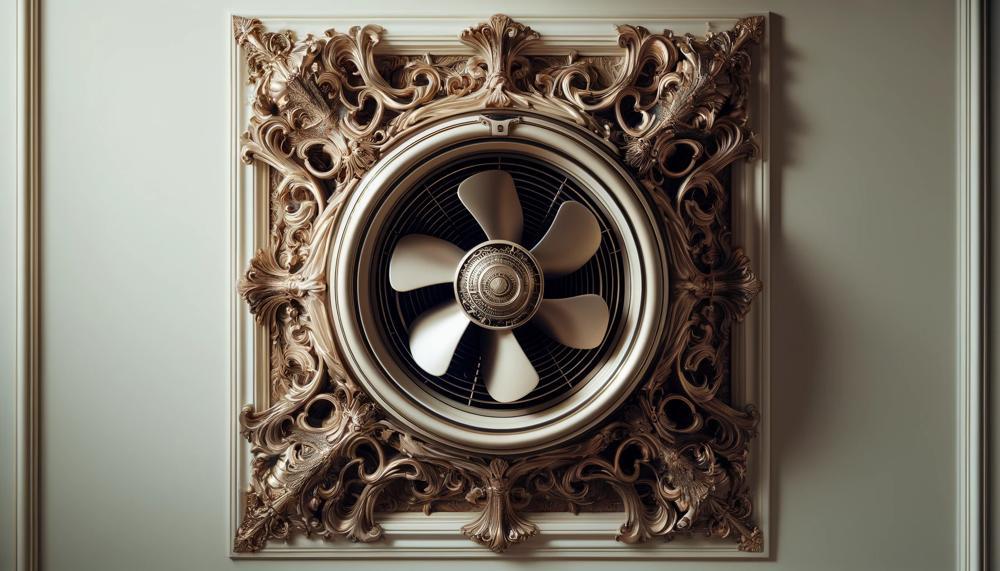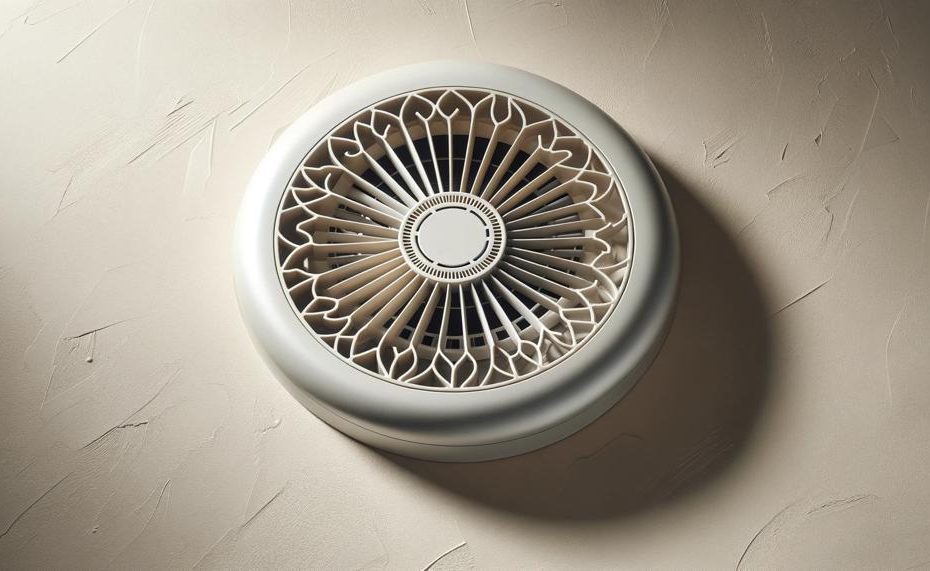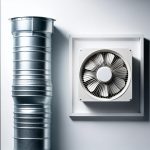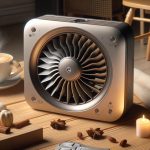Have you ever stepped into your bathroom expecting a gust of fresh air, only to be met with an unexpected breeze from above? If your bathroom exhaust fan seems to be on a rebellious streak, blowing air down rather than drawing it up, you’re not alone in this perplexing situation. This unexpected twist can turn a routine bathroom visit into a moment of wonder and sometimes frustration. But fret not, for this blog post is set to unravel this mysterious airflow anomaly.
So, why is my bathroom exhaust fan blowing air down?
When your bathroom exhaust fan starts blowing air down instead of pulling it out, it can be quite perplexing. Let’s explore the reasons behind this issue and how to address it:
- Stuck Backdraft Flapper: The backdraft flapper plays a crucial role in your bathroom exhaust fan’s function. It allows air to flow out of the bathroom when open but prevents air from sweeping back in when closed. If the flapper gets stuck open, outside air enters the bathroom. Conversely, if it’s stuck closed, the fan may suck in air but blow it right back inside if the flapper obstructs the airflow.
- Reversed Fan Blades: Your bathroom fan consists of three main parts: the cover or housing, motor, and fan blades. The rotational direction of the blades significantly impacts the fan’s function. Ideally, you want the blades to turn clockwise, drawing air upwards. Some fans have alternating motors, allowing you to switch the blade’s rotation direction. If the blade rotates counterclockwise, it could be the reason your fan blows air down.
- Lint Buildup: Although exhaust fans are essential for bathrooms, they often go unnoticed. Lint and debris can accumulate inside the fan or cover plate, affecting its performance.
So, let’s dive in and turn the tide on this airy conundrum.
Contents
Fan Blades Installed Backwards
To determine if your bathroom exhaust fan blades are installed backwards, follow these straightforward steps:
Step-by-Step Guide:
- Check Air Direction:
- Turn on the exhaust fan and stand directly underneath it.
- Feel the air direction. If the air is being blown downwards towards you, this is a strong indicator that the blades might be installed backwards.
- Visual Inspection of Blades:
- Turn off the fan and safely use a ladder to get a closer look at the blades.
- Look for any arrows or markers on the fan housing or blades themselves that indicate the correct installation direction.
- Consult Manufacturer’s Instructions:
- Refer to the user manual or online resources from the fan’s manufacturer for guidance on proper blade orientation.
- Seek Professional Advice:
- If you’re still unsure, consider consulting a professional. An electrician or HVAC technician can provide a definitive answer and correct any installation errors.
Troubleshooting Table:
| Sign | Indicates | Action |
| Air blows downwards | Possible reverse blade installation | Check blade orientation and consult manual |
| No directional arrows found | Possible non-standard unit or worn markings | Refer to manufacturer’s documentation or seek professional help |
| Fan noise or strain | Possible incorrect installation affecting motor | Professional inspection recommended |
Fan Wiring Installed The Wrong Way
Incorrect wiring of a bathroom exhaust fan can lead to a rather bothersome issue: the fan might start blowing air downwards instead of upwards, creating an uncomfortable and potentially mold-inducing environment.
The Heart of the Problem: Reversed Blade Direction
| Usual Wiring Setup | Outcome with Correct Wiring | Outcome with Incorrect Wiring |
| Hot wire to hot terminal, neutral wire to neutral terminal | Fan blades pull air upwards | Fan blades push air downwards |
| Direction of fan blades’ spin | Clockwise (viewed from below) | Counter-clockwise (viewed from below) |
| Effect on Bathroom Environment | Moisture and odours expelled | Moisture and odours linger |
Why Does It Happen?
- Reversed Wiring: If the hot and neutral wires are swapped, the electric motor might run in the reverse direction. This means the blades, designed to scoop air up and out, do the opposite. They press air down, right back into the room.
- Faulty Connections: Sometimes, it’s not about which wire goes where but how securely they’re connected. Loose or improper connections can mess with the fan’s operation, leading to unintended consequences like reversed blade motion.
- Comfort Takes a Hit: Instead of drawing moist air out, the fan blows it down, making the bathroom feel more humid and less comfortable.
- Mould and Mildew Heaven: Moisture not being properly vented invites unwelcome guests like mould and mildew, risking both health and home structure.
- Power Off: Always start with safety. Cut power to avoid shocks.
- Inspection: Check the wiring. Hot should go to hot, neutral to neutral. Look out for any signs of wear or loose connections.
- Correction: Swap the wires back if they’re reversed. Secure any loose connections.
- Call in the Pros: If you’re not confident, or the problem persists, a professional electrician can sort it out, ensuring both safety and functionality.
- Blocked Exit: Imagine the flapper as a one-way gate. If it’s jammed, air can’t leave, causing a backup. This results in the fan blowing air down instead of out.
- Rust or Lack of Lubrication: Just like any hinge, if it’s not moving smoothly, it won’t open. This can be sorted with a bit of oil or, in stubborn cases, a replacement.
- Improper Vent Size or Obstruction: A vent that’s too small, squashed, or clogged is like a narrow country lane clogged with hay bales. Air just can’t get through efficiently, bouncing back into the room.
- Fan Foul-up: If the fan’s blades or innards are put in backward, they’ll push air down, defying the purpose of an exhaust fan.
- Fan Blades or Wiring Snafus: First off, check if the fan blades are facing the right direction and that the wiring doesn’t resemble a bowl of spaghetti. Incorrect installation can turn your exhaust fan into an ineffective room fan.
- Sticky Backdraft Flapper: This little gizmo prevents outside air from sneaking back into your sanctuary. If it’s more stubborn than a mule, air’s going nowhere but down. A bit of lubricant or a gentle nudge might just do the trick.
- Vent Duct Quandaries: Your duct’s size needs to be in sync with your fan’s gusto. Too puny, and it’s like trying to suck a watermelon through a straw. Check for blockages, squashes, or kinks — any of which could be the culprit behind the indoor tornado.
- Decreased Airflow: If your fan seems less powerful or the bathroom remains steamy longer, it’s a clue.
- Unusual Noises: Rattling or buzzing can indicate obstruction in the duct.
- Visible Mold or Excess Moisture: A tell-tale sign of inadequate ventilation.
- Safety First: Turn off the power to the fan at the circuit breaker.
- Inspection: Remove the fan cover and use a flashlight to inspect the ductwork.
- Clearing Debris: Gently remove any visible obstructions such as dust bunnies or nests.
- Checking Exterior Vent: Ensure the outside vent is not blocked by debris or overgrown vegetation.
- Professional Help: If the blockage is not visible or reachable, consider hiring an HVAC professional.
- Cause: The kink or flatten acts as a blockade.
- Effect: Air movement gets stifled, drastically reducing the fan’s ability to expel moist air out.
- Cause: Exhaust fan’s reduced capability to vent air outside.
- Effect: Excess moisture may linger, fostering mold and mildew development.
- Cause: The fan works harder to push air through the constricted duct.
- Effect: This can shorten the lifespan of the fan due to the increased workload.
Broader Impacts:
What to Do:
So, for the folks who relish a well-ventilated bathroom without the hassle of unintended showers from above, ensuring your fan’s wiring is spot on is crucial.
Backdraft Flapper Might Be Stuck Closed
When a backdraft flapper gets stuck in the closed position, it’s like a door that won’t open, trapping air where it shouldn’t be.
This situation can force your bathroom exhaust fan to act out of character, pushing air downwards rather than escorting it out.
Why It Happens: The Nitty-Gritty
Solutions Table:
| Problem | Why It’s a Problem | How to Fix It |
| Stuck Flapper | Prevents air from leaving, causing downward airflow | Lubrication or replacement |
| Rust/Lack of Lubrication | Causes flapper to stick | Apply oil or replace flapper |
| Undersized/Blocked Vent | Blocks airflow, causing air to bounce back | Clear blockage or adjust vent size |
| Incorrect Fan Installation | Blades push air down instead of pulling it out | Check and correct installation |
A Step Towards Fresher Air
If your bathroom feels more like a wind tunnel in reverse, checking the backdraft flapper could be a clever move.
It’s a simple part, but its role is mighty. Keeping it in check ensures your bathroom remains a retreat from humidity and unwanted odours, not a battle against them.
Vent Pipe Or Duct Is Undersized
To discern whether your vent pipe or duct is not adequately sized, causing your bathroom exhaust fan to misbehave by blowing air downward, it’s prudent to eyeball a few tell-tale signs and conduct some rudimentary inspections.
Now, for a more hands-on approach:
| Issue | Signs | Action |
| Fan Blades/Wiring | Fan seems to push air down | Re-install correctly |
| Backdraft Flapper | Increased humidity, odours | Lubricate or replace |
| Vent Duct Size/Blockage | Poor airflow, noise | Clean, replace, or adjust |
To get to the bottom of this, you might need to play detective. Observe if the issue persists even after ensuring everything’s installed correctly, the flapper’s freed up, and the ducts are clear and correctly sized.
If the fan still acts up, a professional look-see might be in order.
Vent Pipe Or Duct Might Be Blocked
Recognizing a blockage in your bathroom exhaust fan’s vent pipe or duct is vital for maintaining a healthy, moisture-free environment. Below is a guide on identifying and resolving blockage issues.
Signs of Blockage
Steps to Fix the Blockage

Choosing the Right Equipment
For those DIY enthusiasts, here’s what you need for the job:
| Tool | Usage | Additional Tips |
| Flashlight | Inspecting the duct | Choose a bright LED light for clarity. |
| Gloves | Protection while cleaning | Wear sturdy gloves to prevent scratches. |
| Screwdriver | Removing fan cover | A multi-head screwdriver is handy. |
| Brush | Cleaning ducts | Long-handled brushes can reach deeper. |
Remember, regular maintenance is key to preventing blockages. This includes routinely cleaning the fan and checking ducts for obstructions. In a nutshell, stay observant, be proactive, and when in doubt, call a pro.
Vent Pipe Or Duct Kinked Or Flattened
When a vent pipe or duct gets kinked or flattened, it’s like squeezing a garden hose while trying to water your plants; the flow gets restricted, and not much water comes out the end.
Similarly, for your bathroom exhaust fan, the air that’s meant to be expelled out gets choked up, causing a significant airflow disruption.
This can force the air to take the path of least resistance, which, in many cases, is back into the bathroom instead of outwards as intended. Here’s how it unfolds:
Impeded Airflow and Reduced Efficiency
Increased Moisture and Potential Mold Growth
Strain on the Fan Motor
To give you a clearer picture, let’s lay down some specifics in a table:
| Aspect | Without Obstruction | With Kinked/Flattened Duct |
| Airflow Efficiency | Optimal | Greatly Reduced |
| Moisture Removal | Effective | Ineffective, raising humidity |
| Fan Lifespan | Longer | Potentially Shortened |
For those passionate about maintaining a spotless and healthy bathroom atmosphere, understanding the critical nature of unobstructed vent pipes or ducts is essential.
Rectifying a kinked or flattened duct not only preserves the integrity of your bathroom’s air quality but also ensures the longevity of the exhaust fan itself.
Conclusion
It can be strange to walk into your bathroom and feel a draft from the exhaust fan blowing down. This air puzzle isn’t just about a fan going crazy; it also reveals greater problems with ventilation, air pressure differences, and the search for the best way to control the temperature and humidity in a home. Realizing that you can fix these problems, such as reversed blades, bad wiring, a non-moving backdraft flapper, or even plumbing issues, can restore your bathroom to its former glory.
From the simple mismatch of fan blades to the electrical flip that makes blades spin in the opposite direction, the piece clearly breaks down these problems. It also talks about the backdraft flapper’s important role in keeping airflow going in the right direction. It is important not to forget that the size and quality of vent ducts play a big role. A kink or blockage in one of these ducts could make the bathroom atmosphere nothing like the relaxing escape it should be.
The article gives homes the tools they need to deal with the breezy rebellion by providing useful information and step-by-step instructions for fixing problems. Solving these airflow problems will not only improve your bathroom experience, but it will also show that you care about keeping your home airtight by removing wetness and odors quickly and effectively, leaving only a clean, refreshing space.





